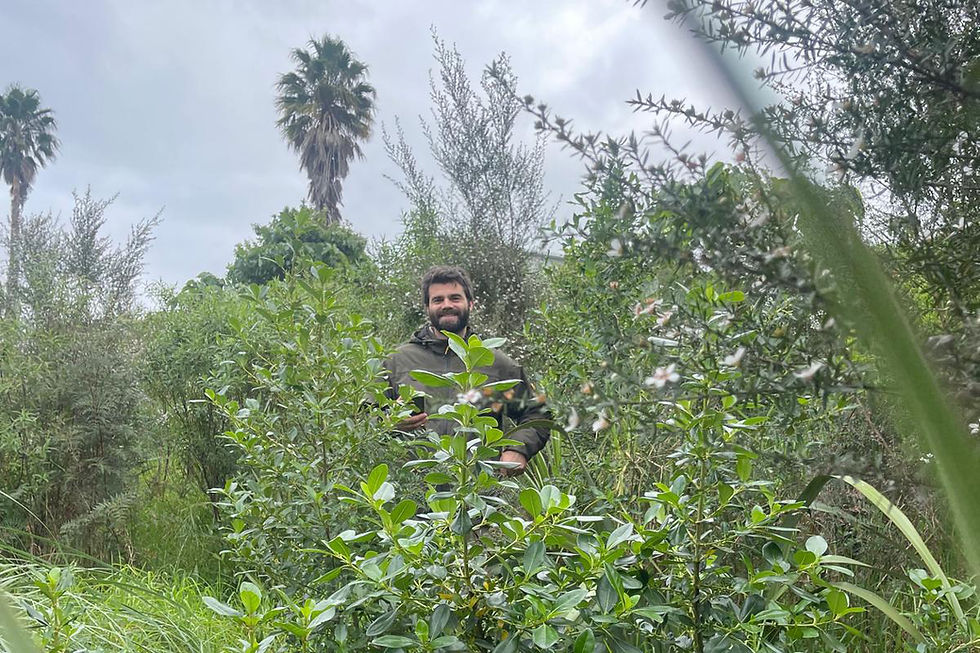Leading with heart and hands
- Te Hōnonga a Iwi

- May 22
- 3 min read

Student journalist Fareh Farhan profiles Youth Leader Miriam Scott who has been making a huge impact at Te Hōnonga a Iwi since the restoration began.
Whether she’s managing our fresh water supply, diverting waste, dealing with feral cats, helping at working bees or keeping the Te Hōnonga a Iwi social media platforms up-to-date, Youth Leader Miriam Scott brings a wealth of enthusiasm and community spirit to our restoration project.
Miriam’s journey with Te Hōnonga a Iwi started with her mother, Nicky Shave, who played a leading role in initiating the project. But Miriam’s involvement wasn’t out of obligation. Her passion for environmental science and sustainability had already started to grow through school, hockey, and even childhood trips to Tiritiri Matangi, where she planted native trees with her whānau. Being a hockey player at North Harbour Hockey, an organisation that became deeply involved in the restoration, only strengthened her bond to the project.
When asked about her favourite roles at the restoration, she doesn’t hesitate. “Being out there in the soil with volunteers and using social media to reach a wider audience have both been fulfilling in different ways,” she says. “I love seeing how many people care about the restoration and social media is just a fun, creative way to show that off to the world.”
Her leadership didn’t come from a title, but from a sense of responsibility. She saw good people doing good work and wanted to contribute. “It was about supporting the team and wanting to see real change in our biodiversity and sustainability,” she explains. That same sense of purpose now drives her academic path.
Currently, Miriam is studying a Bachelor of Global Studies at the University of Auckland, majoring in Global Environment and Sustainable Development, and learning te reo Māori as part of her degree.
Miriam credits Te Hōnonga a Iwi for helping her to understand university-level concepts through real-life application. From learning about nature-based solutions to indigenous environmental knowledge, her work on the project has acted as a bridge between academic learning and community action.
That influence extends to her career goals as well. Through her leadership, Miriam has gained insight into sustainable business management, and she’s now interested in the role of the commercial sector in fighting climate change. “It’s about how businesses can be part of the solution, not just the problem.”
Miriam’s environmental mahi has involved tackling big challenges such as feral cat trapping, water management, and waste diversion. Her approach? Adaptability, commitment, and a willingness to learn. “You don’t have to be perfect or know everything,” she says. “You just need to show up and be ready to help.”

One of her proudest moments was seeing trees she helped plant years ago finally reaching canopy height—a powerful reminder of what long-term restoration looks like.
Another initiative close to her heart is the North Harbour Hockey Association’s waste diversion project, which she explains in detail. By redirecting organic waste from landfills to on-site composting bioreactors, the team has drastically reduced their carbon footprint. The compost is then either sold to lower player costs or used to enrich the Te Hōnonga a Iwi community food garden—supporting new seedlings and growing fresh food. It’s a closed-loop, local solution to global environmental pressures.
As a youth leader, Miriam leads by example: working hard, teaching new skills, and being approachable. One core leadership lesson she’s learnt is that every volunteer shows up with different motivations. Understanding these reasons, she believes, is key to building a thriving, inclusive project. And over time, she’s noticed a genuine shift in the attitudes of local rangatahi. “Young students expect sustainability,” she says, “They’re not passive; they want to contribute.”

Looking ahead, Miriam dreams of expanding Te Hōnonga a Iwi all the way to the coast and hopes local businesses will also green their spaces. She envisions a future where biodiversity thrives and wildlife returns. For youth who want to get involved in conservation, her message is simple and encouraging: “You don’t need experience—just a willingness to serve and share your strengths.”
If given the chance to lead a new initiative, Miriam would love to see rooftop gardens pop up across the city; cooling urban spaces and creating green corridors for birds and insects to migrate safely. It’s this kind of creative thinking, grounded in practical action, that makes Miriam Scott such an impactful voice in the restoration community.
Through Te Hōnonga a Iwi, Miriam has proven that young people aren’t just the leaders of tomorrow—they’re already leading today.





Comments